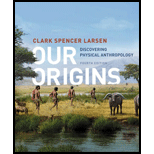
Concept explainers
Introduction: The humans are classified into three types based on the transition of external features and adaptability to the environment. They are Homo. Erectus, archaic Homo sapiens and modern Homo sapiens.
Explanation of Solution
Correct answer: Option d. Reduction in skeletal robusticity.
Reasons for the correct answer:
The archaic Homo sapiens is the first of human species that evolve locally from early Homo erectus population. They consist of mixture of Homo erectus and Homo sapiens characteristics. The reduction in the robusticity of skull and skeleton differentiates the archaic Homo sapiens from Homo erectus.
Option d. is given as “reduction in skeletal robusticity”.
Hence option d is correct.
Reasons for the incorrect answers:
Option a. is given as “presence in Asia and Europe”. The archaic Homo sapiens and Homo erectus distributed over Asia, Africa, and Europe. Hence, option a is incorrect.
Option b. is given as “loss of large browridges”. The loss of large browridges occurs in the modern Homo sapiens. Hence, option b is incorrect.
Option c. is given as “development of a projecting chin”. The development of projecting chin occurs in modern Homo sapiens. Hence, option c is incorrect.
Therefore, options a), b), and c) are incorrect.
Thus the reduction in skeletal robusticity distinguishes early archaic Homo sapiens from Homo erectus.
Want to see more full solutions like this?
- Dolphins and fish have similar body shapes. Is this feature more likely a homologous or analogous trait?arrow_forwardWhich conditions would NOT lead to good preservation of a dead hominin skeleton? Group of answer choices A: Dying in a very dry dessert B: Dying in the marsh alongside a lake C: Dying in an open grassland that is seasonally dry or wet. D: Dying in a cavearrow_forwardWhat is one anatomical difference between Australopithecines and other early hominins, such as Ardi? A. There were no anatomical differences between Ardi and the Australopithecines. B. Ardi had a divergent big toe while the Australopithecines had non-divergent big toes. C. Australopithecines had more facial prognathism than Ardi. D. Australopithecines had larger canines than Ardi.arrow_forward
- What two species did early Homo sapiens live with during the end of the Pleistocene? A. Sahelanthropus tchadensis and Denisovans B. Neanderthals and Ardipithecus ramidus C. Neanderthals and Australopithecines D. Neanderthals and Denisovansarrow_forwardWhich features characteristic of humans are unlikely to fossilize? a. the bones and dung b. the jaws and dung c. behavioural and soft tissue features d. behavioural and hard tissue featuresarrow_forwardAs hominins diverged from other primates, which of thefollowing appeared first?(A) reduced jawbones(B) an enlarged brain(C) the making of stone tools(D) bipedal locomotionarrow_forward
- Which is NOT true about Homo habilis: A) considered the first tool maker B) had a smaller brain the australopiths C) associated with the Oldowan tool industry D) was bipedalarrow_forwardWhen did the different species of Homo appear? Differentiate on how their cultures differ.arrow_forwardWhat kind of tools did Lucy and other Australopithecines most likely use? A. An advanced stone tool like the Acheulean hand axe B. Wheelbarrows C. A bow and arrow D. A crude stone tool like the Oldowan Chopperarrow_forward
- Despite the differences in neck length, mice, humans, and giraffes all have seven cervical vertebrae. This is an illustration of A. missing links. B. homologous structures. C. vestigial structures. D. analogous structures.arrow_forwardExplain three possible reasons why Homo erectus left Africaarrow_forwardAfrican Homo erectus cranial features include A. Thick cranial bones. B. Small browridges. C. A rounded skull. D. A sagittal crest.arrow_forward

 Concepts of BiologyBiologyISBN:9781938168116Author:Samantha Fowler, Rebecca Roush, James WisePublisher:OpenStax College
Concepts of BiologyBiologyISBN:9781938168116Author:Samantha Fowler, Rebecca Roush, James WisePublisher:OpenStax College Human Biology (MindTap Course List)BiologyISBN:9781305112100Author:Cecie Starr, Beverly McMillanPublisher:Cengage Learning
Human Biology (MindTap Course List)BiologyISBN:9781305112100Author:Cecie Starr, Beverly McMillanPublisher:Cengage Learning


